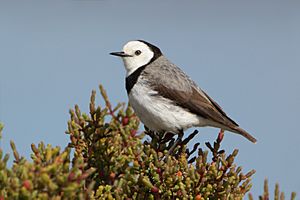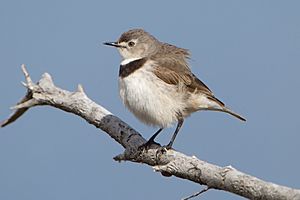White-fronted chat facts for kids
Quick facts for kids White-fronted chat |
|
|---|---|
 |
|
| male | |
 |
|
| female | |
| Conservation status | |
| Scientific classification | |
| Genus: |
Epthianura
|
| Species: |
albifrons
|
| Synonyms | |
|
Acanthiza albifrons Jardine & Selby |
|
The white-fronted chat (Epthianura albifrons) is a small bird that lives in southern Australia. It belongs to the honeyeater family. The male bird has a bright white face with a black band across its chest. These birds mainly eat insects.
Contents
About the White-fronted Chat
Scientists first described the white-fronted chat in 1828. Later, in 1838, a scientist named John Gould gave it its current scientific name, Epthianura albifrons.
The name albifrons comes from Latin words: albus meaning 'white' and frons meaning 'forehead'. This describes the bird's white face.
People have given this bird many fun nicknames over time. Some call it "tintack" or "tang" because of its unique call. Others call it "moonface" or "baldyhead" because of its white face.
What Does It Look Like?
Adult white-fronted chats are about 11 to 13 centimeters (4 to 5 inches) long. They weigh between 11 and 17 grams (about 0.4 to 0.6 ounces).
- Males: Have a white face and chest. A black band goes across their chest and around the back of their neck. Their upper body is silver-grey, and their wings are dark brown. Their eyes are usually pinkish-white.
- Females: Look a bit different. Their upper body is grey-brown, and their underside is white or light grey. Their black chest band is usually lighter than the male's. Female eyes are brown.
When these birds fly, they make a metallic "tang" sound. It sounds a bit like a rubber band twanging!
Where Do They Live?
The white-fronted chat lives only in Australia. You can find them across southern Australia, from Shark Bay in Western Australia all the way to Queensland. They also live in Tasmania.
They like open areas with low plants. This includes places like:
- Saltmarshes
- Coastal sand dunes
- Swamps or mangrove edges
- Areas around inland salt lakes
In wetter parts of Australia, they usually stay in one place. But in drier areas, they might move around to find food and water.
How Do They Behave?
White-fronted chats are often easy to spot. They like to sit on top of bushes, grassy clumps, or fences. However, they are very careful when they are near their nests. They might even pretend to be hurt to lead predators away from their babies.
These birds often live together in small groups or colonies.
Reproduction and Life Cycle
The breeding season for white-fronted chats is from June to January.
- The female builds a cup-shaped nest.
- She uses grasses and twigs, lining it with soft materials like fine grass, feathers, and animal hair.
- The nest is usually hidden well in a low bush or a clump of grass.
- The female lays 2 to 4 eggs.
- Both parents take turns sitting on the eggs for 13 to 14 days.
- The eggs are white with reddish-brown spots.
- Once the chicks hatch, both parents feed them.
- The young birds are ready to leave the nest after 10 to 15 days.
Sometimes, another bird called the Horsfield's bronze cuckoo lays its eggs in the chat's nest. This is called brood parasitism, where the cuckoo tricks the chat into raising its young.
What Do They Eat?
White-fronted chats usually look for food alone or in small groups. They search for insects in low bushes or on the ground.
Their diet includes many different kinds of insects:
- Beetles
- Ants
- Bees
- Grasshoppers
- Moths and caterpillars
- Spiders
They also sometimes eat acacia seeds and nectar from flowers.
Conservation Status
The white-fronted chat is a bird of "Least Concern" globally, according to the IUCN Red List. This means it is not currently in danger of disappearing worldwide.
However, in some parts of Australia, their numbers have gone down.
- In New South Wales, they are listed as "vulnerable" because their population dropped by 65% between 1981 and 2005.
- In the Adelaide-Mount Lofty area of South Australia, they are considered "threatened" and have become much rarer.
See also
 In Spanish: Eptianuro pío para niños
In Spanish: Eptianuro pío para niños


